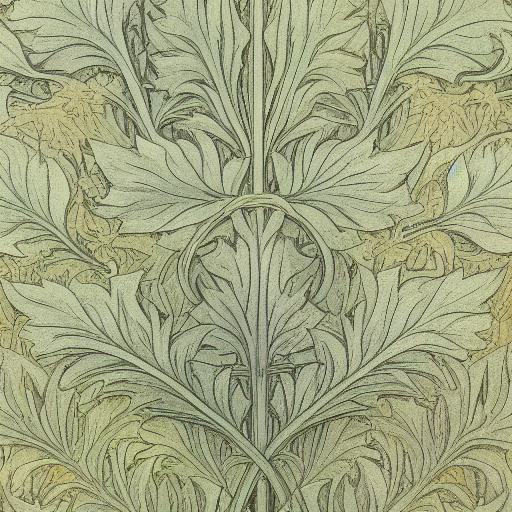Leaves in Art Nouveau
In Art Nouveau, leaves are often used as decorative elements alongside flowers. They play a significant role in capturing the essence of nature and organic forms that are characteristic of the Art Nouveau style. Leaves symbolize growth, vitality, and the interconnectedness of all living things, which aligns with the overarching themes of naturalism and harmony with the environment that Art Nouveau seeks to convey.
Leaves in Art Nouveau are typically depicted in sinuous, flowing lines, often resembling the curving shapes found in plants and vines. They are intricately rendered with meticulous attention to detail, showcasing the artist’s dedication to capturing the beauty of nature. The use of leaves as decorative motifs adds depth, texture, and visual interest to the overall composition of Art Nouveau works.
Additionally, leaves serve as a complement to the floral elements in Art Nouveau, creating a balanced and harmonious composition. The combination of flowers and leaves represents the interconnectedness of different elements in nature, reflecting the belief in the unity and interdependence of all living things.
The presence of leaves in Art Nouveau artworks not only adds aesthetic appeal but also reinforces the organic and naturalistic aesthetic that defines the style. It enhances the sense of movement, rhythm, and fluidity, contributing to the overall visual impact of the artwork. Leaves in Art Nouveau are a testament to the artist’s appreciation for the beauty and vitality of nature, inviting viewers to connect with the natural world through art.
Art Nouveau pattern as wallpaper
The use of wallpaper in Art Nouveau was not merely functional but also a way to express artistic and decorative ideas. The intricate patterns and elaborate designs reflected the desire to bring beauty and artistry into the domestic environment. Art Nouveau wallpaper aimed to create immersive and visually captivating spaces, enveloping the viewer with a sense of elegance and refinement.
Moreover, Art Nouveau wallpaper designs often showcased a sense of balance and symmetry. They were meticulously crafted to fit seamlessly into the architectural spaces they adorned, creating a cohesive and harmonious visual experience. The wallpaper patterns enhanced the overall aesthetic of the interior, complementing the other decorative elements and furnishings in the room.
Art Nouveau wallpaper became immensely popular during the late 19th and early 20th centuries, reflecting the desire for a new, modern aesthetic that departed from the ornate styles of the past. The distinctive patterns and motifs of Art Nouveau wallpapers continue to captivate and inspire designers and art enthusiasts to this day, as they embody the spirit of this artistic movement and its emphasis on harmonious and organic design.
Creating artistic pattern with AI Prompt
When generating images with AI generator, such as Midjourney and Stable Diffusion, one of the way to generate images is text prompt to image. Let’s explore the prompt “A close-up of a pattern of plants and leaves, reminiscent of a mid-nineteenth century engraving by William Morris, influenced by the Arts and Crafts movement and Art Nouveau”. The prompt highlights the following elements:
- Close-Up of a Pattern of Plants and Leaves: The focus of the painting is on a detailed close-up view of a pattern composed of plants and leaves. This suggests a botanical theme and intricate foliage that will be central to the artwork.
- Mid-Nineteenth Century Engraving by William Morris: The prompt draws inspiration from the work of William Morris, a prominent figure in the Arts and Crafts movement known for his exquisite engravings. This suggests a desire for a style reminiscent of Morris’s intricate and decorative designs.
- Arts and Crafts Movement: The prompt references the Arts and Crafts movement, which emphasized craftsmanship, nature-inspired motifs, and the integration of art into everyday life. The painting will reflect the principles and aesthetics of this movement, including a focus on intricate details and a celebration of nature.
- Acanthus Scrolls: The mention of acanthus scrolls indicates a specific decorative element commonly used in 19th-century engravings and the Art Nouveau style. These scrolls feature intricately curling leaves, adding an ornate and organic touch to the pattern.
- Art Nouveau: The prompt connects the artwork to the Art Nouveau movement, known for its flowing lines, organic forms, and nature-inspired designs. This influence will be reflected in the overall composition, further enhancing the connection to Morris’s work.
Once you have generated the images that meet your specific needs, you can utilize them directly or incorporate them into your design projects. With powerful design tools like Visual Paradigm Online, you can leverage the generated images to unleash your creativity and bring your ideas to life. By seamlessly integrating the images into your design workflow, you can create stunning and visually captivating compositions that leave a lasting impression. Let your imagination soar and harness the potential of AI-generated images to enhance your design process.


